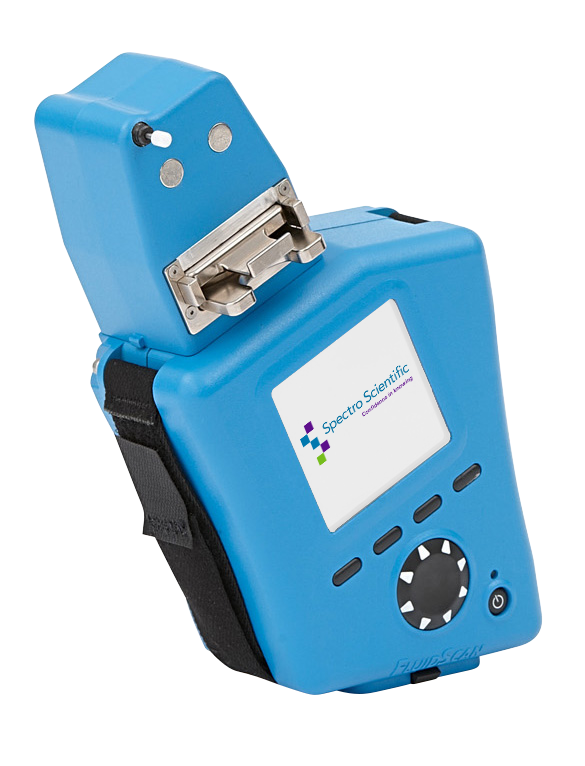Enable your service team with a portable oil analyzer
It is not an easy task to accurately assess the condition of lubricating oil after a sample has been taken from your machinery. Such timely information is critical in helping service engineers to identify potential problems and to plan appropriate maintenance actions. Lubricant condition can be expressed in terms of oil degradation and contamination and they differ in reciprocal engines (off and on highway truck fleet, automotive fleet, marine vessel fleets) and in rotating machines (commonly used in industrial manufacturing plants). These difference are summarized in the table below
|
|
Rotating machines |
Reciprocal engines |
|
Oil degradation |
Oxidation, Acidity (Total Acid Number) increase |
Oxidation, Nitration, Sulfation, anti-wear additive depletion, alkaline reserve (Total Base Number) depletion |
|
Contamination |
Water, wrong oil |
Water, Coolant, Fuel, soot |
Normally such an analysis is carried out in labs with sophisticated analytical instruments miles away from the assets. The results and analysis are accurate, but the time lag from when oil samples are drawn to when a report is received can create a challenge for the service engineer. Current trends show that on-site oil analysis tools are being implemented in industrial manufacturing plants, power plants, mining sites, and truck servicing shops to improve oil analysis turnaround time. By doing so, millions of dollars are saved by eliminating inefficiencies in maintenance practices, including cost of labor, materials and unplanned downtime.
Service professionals from lubricant supply companies and machine OEMs cannot easily use on-site laboratory analysis tools as their customers can be quite far away from each other. Ideally they would like to identify the condition of the lubricant in a customer’s critical asset when a service engineer is right there troubleshooting a problem and there is an urgent need for portable oil analysis tool. The ideal tool should be portable, accurate, repeatable, fast, easy to use, versatile (can measure many different oils) with no waste, no hazardous chemicals, and have a simple data export capability..
Spectro Scientific’s FluidScan Q1000 is a handheld Infrared oil analyzer originally designed for the Fast Field Fluid AnalyST (3FAST) program initiated by the US Department of Defense (DOD) The FluidScan was later introduced to the market for commercial applications. Several unique features make the FluidScan the ideal tool for service professionals to perform on site oil condition analysis for their customers [1,2,3,4]:
- Rugged – Unlike FTIR analyzers commonly found in the lab, the FluidScan uses a miniature diffraction grating as its core optics. This design eliminates moving parts making the FluidScan much less sensitive to shocks and vibration during transportation This critical design feature makes it portable and durable, while still maintaining the analytical performance of a lab instrument.
- Light – is battery operated and weighs 3 pounds making it ideal for handheld operation
- Fast – results in minutes
- No waste – only one drop of oil (20 – 30 microliters) is needed for analysis
- No chemicals – after measurement, the oil is wiped off the sampling cell without the need of any chemicals, using a non-abrasive wipe
- Comprehensive and accurate – results cover most IR properties (Oxidation, Nitration, Sulfation, antiwear additive, Soot), as well as those normally requiring a titrator (Water, TAN, TBN) . Results correlate to lab results.
- Repeatable -3% repeatability
- Versatile – a library of over 500 oils covers both industrial (hydraulics, gear, compressor, turbines, etc.) and fleet (gas, diesel, natural gas engines, locomotive, marine two and four- stroke engines, etc.) applications. Covers over 60 major oil brands worldwide. [5]
- Expandable – A match function helps find the closest match foroils not listed in the library. A one-time adjustment per new oil can be made by users after matching for lab correlation. In addition, the core oil library grows every month as oil samples are collected worldwide by our applications group.
- ASTM compliant – complies to newly established ASTM method D7889 - Standard Test Method for Field Determination of In-Service Fluid Properties Using IR Spectroscopy
FluidScan data can be exported to a .csv file and then uploaded to any data management system. Combined with SpectroTrack, Spectro data management and LIMS software, which can be installed locally or hosted in a cloud, data from multiple FluidScans can be sent to a SpectroTrack server directly via the internet, simplifying the management of multiple devices for a large service team.
References:
[1]: , Spectro Scientific white paper Overview of FluidScan Handheld Infrared Oil Analyzer
[2]: Using Infrared Spectroscopy for the Determination of TAN and TBN in Machinery Lubricant Oils, Spectro Scientific white paper
[3]: Measuring Water with the FluidScan Fluid Condition Monitor, Patrick Henning, Spectro Scientific.
[4]: Under the hood, meeting the design challenge of FluidScan handheld oil analyzer, Spectro Scientific white paper

